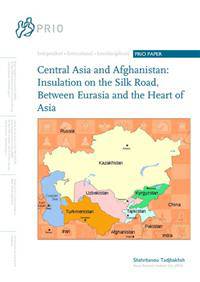Is Afghanistan the heart of Asia, from where regional security can be threatened and cooperation induced? Or is it an artificial heart whose beat does not echo the genuine security interests of neighbouring countries? This question is the essence of the PRIO research project ‘Afghanistan in a Neighbourhood Perspective’, which this third paper in the series aims to answer from the point of view of the Central Asian Regional Security Complex (CA RSC).
In the lead-up to the Bonn II Conference by the end of 2011, the USA and Coalition partners had broadened their ‘regional approach’ to peace in Afghanistan from its initial narrow focus on the AfPak region, to a new ‘Heart of Asia’ concept which cast Afghanistan as the political and economic hub of a conglomeration of regional countries, near and distant. The widened approach was based on two assumptions: First, that potential insecurity instigated by the destructive behaviour of non-state actors necessitated new collective security arrangements for all neighbouring countries; and second, that the stabilization of Afghanistan would herald positive externalities and economic dividends, which the US administration envisioned as a New Silk Road. Yet, the ‘Heart of Asia’ concept had two conceptual limitations in addition to a number of political impediments. First, it fundamentally underestimated the potential for non-cooperation among states, even if they shared common concerns for dangers emanating from non-state actors. Second, by assuming that there was a large region where interests merged for cooperative security, the ‘Heart of Asia’ vision failed to recognize genuine security dynamics within sub-regions and how Afghanistan is surrounded by three Regional Security Complexes (RSCs), each with its own security dynamic.
The author argues that the Central Asian states’ (lack of) involvement with Afghanistan is reflected specifically by this RSC’s internal rivalry and common need to balance external actors. While CA countries are concerned about insecurities stemming from Afghanistan, their main security problems lie elsewhere.
This paper forms part of the project 'Afghanistan in a Neighbourhood Perspective', funded by the Royal Norwegian Ministry of Foreign Affairs. The project has previously published a general overview and conceptualisation paper (authored by Kristian Berg Harpviken), and a paper on Afghanistan and South Asia (authored by Shahrbanou Tadjbakhsh). The fourth paper to be published will concern Afghanistan and the Persian Gulf.








